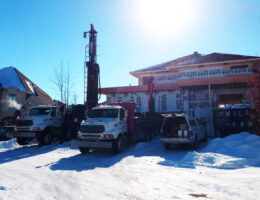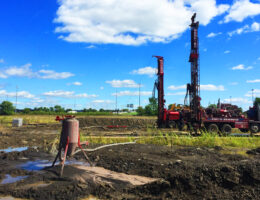Saint-Eugène primary school
A beautiful project at Saint-Eugène school in St-Jean-sur-Richelieu which lasted 1 month and which required the drilling of 32 wells for the school to be powered by geothermal energy. The work was done in August so that everything is ready for the start of the school year.
Bolton-Est
Our team drilled an artesian well in Bolton-Est, a small municipality in the Memphrémagog RCM. We were charmed by the terrain near the nature of this future residence. Although access to the terrain was uneven, it was not a problem for our machinery and our experienced team.
Mercier Primary School
We drilled 18 geothermal wells with a depth of 400 feet each. St-René Elementary School in Mercier on the South Shore of Montreal will now be able to benefit from the advantages of geothermal energy. Stable temperature and energy savings.
La Côte-de-Beaupré
Drilling an artesian well for this residence in Saint-Férréol-les-Neiges, a small municipality located in the county of La Côte-de-Beaupré. The drilling was dug into the rock at a depth of 300 ‘. The work was finished in a few hours.
A geothermal system in an existing house
As we’ve often said, it’s very possible to install a geothermal system in an already built house. What should you look out for before, during, and after installation? Here are a few things to consider.
Underground utilities
The contractor will have to dig around your house to install the underground loop for your geothermal system. There are probably a number of utilities already buried around your house. Electrical cables, water, and gas pipelines, sewers and the leach field are just some sites that must be known, so as to avoid when digging.
Surveying your lot is needed to establish boundaries, as well as locations, rights of way, and setbacks.
The electrical system and existing ducts
Since one of the benefits of geothermal energy is its low demand for electricity, it’s very possible that we don’t need to increase the electrical power in your home. However, it’s best to check first and make sure.
In the past, most residential electric heaters were designed to reduce the airflow needed to heat your home, reduce duct size, and reduce costs. But since more air must be circulated for a geothermal system to produce the same amount of heat in your home, your contractor may recommend that you change some air ducts to make the system sufficient for the necessary air flow.
Your system will then be more efficient, with less potential for problems caused by air noises.
Landscaping
Installing the ground loop for your geothermal system may cause some damage to your landscaping. A horizontal loop requires excavation work and digging around your house. You may have to cut down trees or shrubs to install the underground loop.
Location plan for the underground loop
According to CSA standards (the international standard for energy management in Canada), once your geothermal system installation is complete, you’ll need a plan to indicate the location of the underground loop.
This plan can be very useful when you (or a future owner) want to make changes to the landscaping, such as installing a decorative fountain or planting a tree. It’s recommended to place the plan in an envelope and keep it in a safe place.If you’re thinking of buying a home with a geothermal system, don’t forget to ask for this plan.
If you have any further questions about geothermal energy, please don’t hesitate to contact our team. We’ll be happy to answer you!
Water quality when purchasing a home
There are several things to consider when purchasing a home with an artesian well. First, at your cost, you’ll need to have your water quality analyzed by an independent expert, as a recent water quality analysis is usually required by financial institutions before they’ll lend money to a buyer.
Infortunately, since this analysis is not adequate for ensuring that everything is in order, several other things need to be considered.
You’ll need to, above all, verify the condition and the proper functioning of the well system, especially the pump and the well head. If you are not familiar with wells, it’s best to contact a well specialist for a thorough inspection in order to avoid any unpleasant surprises.
The seller can help you
You can gather a lot of information from the seller.
Here’s what we recommend asking the seller for in terms of information, reports and documents:
- Ask for everything there is to know about the construction, maintenance and condition of the artesian well.
- Ask for the drilling report, which was created during the drilling of the well. This document allows you to understand more about the drilling method used, the depth of the well, the tubing and the inlet filter.
- Ask to see all the maintenance reports following construction as well as the inspection reports for the pump system.
- Ask for all water quality tests performed since the well’s construction.
Following the request for this information, you’ll have all your facts so you can make a well-informed decision during the purchase of your home with an artesian well.
If the seller doesn’t have this information
It may turn out that the seller doesn’t have all this information. If this is the case, contact us to perform an expert inspection of the well. With this, you’ll know: the depth of the well, the flow it currently provides (as the flow can vary over time) as well as the general state of the pump system. At your discretion, we can perform a bacterial analysis at the same time.
To perform this inspection, you’ll need to have authorization from the seller, an adequate pump system in place, and the well must be easily accessible.
If you have questions regarding artesian wells, please don’t hesitate to contact a member of our team. We’ll be happy to respond.

Come meet us!
The Puits Bernier team will be at the Expo habitat Estrie and Expo habitat Québec for the 2019 season!
Expo habitat Estrie
From February 14 to 17, 2019, visit the Sherbrooke Exhibition Center for the 37th annual Expo habitat Estrie. You’ll be able to share your projects with our team, who you’ll find at booth #134.
Expo habitat Québec
Take advantage of the expertise of some 300 exhibitors from February 20 to 24, 2019 at the Expo habitat Québec. Come and meet our team at the ExpoCité Fair Center! We’ll be waiting at booth #18.
Thanks to the vast numbers of exhibitors and conferences at these two Expos, you’ll find thousands of ideas for all your construction and renovation project needs.
What should I do if my well is running short of water?
It is very rare that an artesian well will run short of water during its first year of use. However, it is important to remember that an artesian well is directly influenced by nature and therefore unforeseeable events can occur, reducing the efficiency of your well. For example, water channels can become blocked or dry up. This may result in reduced water pressure, intermittent water flow or total loss of water flow.
What options should I consider?
First, you need to determine the cause. The problem may simply be the result of a defective pump or damage to one of the components of the pumping system. However, if there is nothing wrong with the pumping system, you should have your well inspected to identify the problem.
Once the inspection has been performed, you will have two options to choose from:
- Deepening your well
- Hydraulic fracturing
Deepening your well
Depending on the age of your well and the needs of your household, both options may be possible. Here are a couple of scenarios where deepening your well would be the most feasible solution.
- Since a minimum of 300 feet is recommended for effective results with hydraulic fracturing, your well may simply not be deep enough for this option.You must also take the length of the steel casing into account. If it does not extend above ground, it will have to be extended to conform to the regulations in force at the time the work is performed.
- You have already tried hydraulic fracturing but the results failed to increase the well yield.
Hydraulic fracturing
In all other situations, we have obtained excellent results using hydraulic fracturing and, in our opinion, it is the best solution for low well yield. This technique can be done quickly and the final cost is determined in advance, before work is begun, since there are almost never any unexpected surprises during hydraulic fracturing, which is not the case with well deepening. No excavation is required and you can use your water the same day, unless the slide breaks during the work, which is a very rare occurrence.
What is the minimum quantity of water needed?
The World Health Organization (WHO) recommends a minimum of 20 liters of water daily per person to the meet the basic needs of hydration and personal hygiene. The WHO further specifies that 50 liters are needed to live decently but, to live comfortably, 100 liters of water are required. Yet, the average Quebecer consumes more than 570 liters of drinkable water per day (2015).
If you have any questions concerning your artesian well, please do not hesitate to contact our team of experts.
Références : http://www.environnement.gouv.qc.ca/eau/strategie-quebecoise/strategie2018-2030.pdf
Bernier Wells is growing – positions to be filled quickly!
Bernier Wells is currently looking for candidates to fill the following positions:
- 2 Pumping System Installers in Estrie
- 2 Drillers and Assistant Drillers in Estrie
- 2 Day Laborers in Estrie
- 1 Mechanic in Estrie
- 1 Estimator in Estrie
- 2 Sales Reps in the Quebec area
- 1 Project Manager in Estrie
Join our team!
Take a look at our open positions and send us your CV
Vimont-Auteuil School
Puits Bernier signs a contract for geothermic drilling for the new school in Laval. A bonus for the comfort of all teaching staff and students of Vimont-Auteuil School, who will benefit from a renewable energy source throughout the school year.




